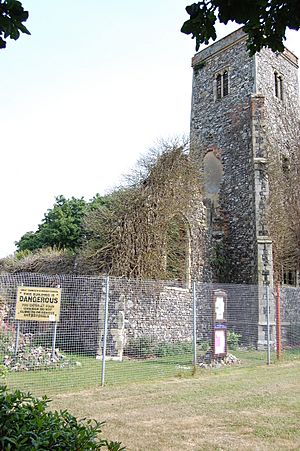St Margaret's Church, Hopton facts for kids
St Margaret's Church is a special church in Hopton-on-Sea, a village in Norfolk, England. It is named after St Margaret of Antioch. There are actually two St Margaret's churches here: an old one that is now in ruins, and a newer one built after the old one burned down. Both churches are very old and important, so they are listed as Grade II* buildings. This means they are considered historically and architecturally significant. Hopton-on-Sea used to be called just Hopton until 1974.
Contents
The Old St Margaret's Church
The original St Margaret's Church (52°32′20″N 1°43′47″E / 52.5388°N 1.7297°E) was built a long time ago, between 1189 and 1250. It had a simple design with a main hall (called a nave) and a square tower. Later, around 1350, a side section called the north aisle was added. People say the stone for this part came from another church, St Mary's in Newton, after it fell into the sea.
The church was mostly built from flint, a common stone in the area. It had a thatched roof, which means the roof was made of straw or reeds. Inside, there was a stove to keep people warm.
The Fire of 1865
On Sunday, January 8, 1865, after the morning church service, the stove was left burning. It got too hot and caught fire. Because the roof was thatched, the fire spread very quickly. The church could not be saved, but thankfully, important church records were rescued from the flames.
After the fire, the church was left in ruins. For many years, ivy grew all over the walls. Even though the church was ruined, the churchyard was still used for burials until 1966. A small room at the base of the tower was kept open for this purpose.
Restoring the Ruins
Over time, the ruins became very worn down. In 2008, the Hopton Parish Council bought the ruins for just £1. A project to restore them began, and by 2017, the ruins were reopened to the public. This also meant they were removed from a list of historic buildings that were at risk of being lost forever. Sadly, the ruins were attacked by arsonists in 2019.
The New St Margaret's Church
The new St Margaret's Church (52°32′23″N 1°43′15″E / 52.5397°N 1.7208°E) was built in the garden of Hopton House. The land was owned by James Henry Orde, whose wife came from a famous banking family in Norwich.
Design and Features
The famous church architect Samuel Sanders Teulon designed the new church. It is considered one of his most important works in Norfolk. The church is built from flint and other stones, with special details made from limestone. It has a style similar to the old church, called Early English.
A large square tower stands in the middle of the church, which is a common feature in Teulon's designs. There is also a round staircase tower with a tall, pointy roof on one corner.
Stained Glass Windows
The beautiful stained glass windows were added later. They were made by William Morris and Company, based on designs by Edward Burne-Jones. The windows in the main part of the church (the chancel) were installed in 1881 and show ideas like humility, faith, hope, and charity. The large window at the east end, added in 1901, shows the Resurrection.
One part of the church, the south transept, has been turned into a special chapel dedicated to Julian of Norwich. It has modern stained glass made by the artist Paul Quail.
The Organ and War Memorial
The church organ was built by George Holdich in 1866. It replaced the organ that was lost in the fire at the old church. Over the years, other companies like Norman and Beard, and Gray & Davison, have worked on and cleaned the organ.
Outside in the churchyard, there is a war memorial. It is a crucifix on a tall stone column, with an image of the Virgin and child on the back.
The Vicarage
The vicarage, which was the home for the church's vicar, was located on Warren Road. In the 1980s, the vicar's wife, Sandra Chapman, ran a bed and breakfast there. By the 1990s, the vicarage had been sold and became a nursing home. The nursing home closed in 2014. The old vicarage building was then taken down in 2015 and replaced with holiday homes.
Notable Burials
Old Church
- James Hanway Plumridge, an Admiral and Member of Parliament.
- His third wife, Georgina Skinner Plumridge.
- The Sayers family, who owned Hopton House. Many of their family members are buried in a brick vault in the old church. There was also a marble monument for John Sayers, who commanded a ship called the Ranger that was lost in a storm in 1822. This monument was destroyed in the fire.
New Church
- Adrian Hope, the son of Colonel William Hope (VC).


